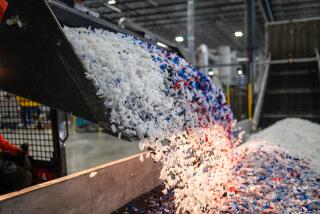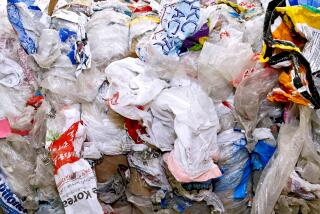Container Refunds Expected to Give Recycling a New Life
- Share via
Verdun Harris was nearly brained not too long ago by a beer bottle tossed carelessly at a trash bin on Sunset Beach.
Fortunately, Harris ducked in time, and the bottle landed harmlessly to his side as he was collecting aluminum cans from the bin. Harris, a retired roofer, had already covered about 50 yards of the sandy beach in his search for cans and any other collectibles that caught his metal detector’s fancy. But he didn’t bother with the beer bottle. Not then.
Now, said Harris, 62, it’s a whole new ballgame.
“I should have picked up that bottle that nearly decked me and said ‘thanks’ to the guy that threw it,” he laughed.
Beginning Oct. 1, each bottle, can and plastic beverage container will be worth a penny to consumers in the state under a new law that analysts believe will have a significant impact on recycling in Orange County.
The law mandates the addition of 2,700 new recycling centers in the state, with 208 to be located in Orange County. Besides reducing the amount of visible litter on streets and in parks, the law may help to reduce the flow of waste material that ends up in county landfills, officials said.
There will probably be more people getting into the business of recycling, and some cities may even resume residential curbside pickup of recyclable materials, an innovation popular a decade ago but abandoned by many cities because of the expense.
In beach communities, where glass, in the form of broken bottles, is a hazard as well as an eyesore, officials said the law will be a tremendous boon.
The new law will probably also boost contributions to charitable organizations and even non-charitable associations. Many recycling projects are expected to be established to take advantage of beverage container refunds.
Consolidated Volume Transporters, a division of Anaheim Disposal, is sponsoring a program in which some of the county’s major restaurants, bars and hotels are recycling bottles and glass containers. Barry Love, CVT’s director of operations, said so far the project has signed up 55 establishments in several northern county cities, including the Disneyland Hotel and Benihana’s, Cattleman’s and Rueben’s restaurants. Several are donating the money they receive to charities.
Despite the obvious benefits, all officials agree that for the new law to work, Californians must recycle. And most admit that it will take a while for some consumers to change a mind set that automatically relegates unwanted material to the trash can.
“Certainly, it will take time to change people’s minds about how they go about their daily lives and what they do and don’t throw away,” said Peter Whited, regional manager of the Reynolds Aluminum Co. and the Orange County representative on a 12-member state advisory committee on the beverage container law.
“And there will be a certain type that a penny won’t move. But this law is a compromise that was worked out that really everyone benefits from. It will take time and educating the public about those benefits.”
Besides the basic component of a penny-per-container refund, the California Beverage Container Recycling and Litter Reduction Act--the result of a 20-year battle of environmentalists against retailers and the beverage industry over proposed bottle bills--is a sometimes-complicated document. Among its main provisions and effects:
- Beginning Sept. 1, beverage distributors began paying the state a cent for every container sold.
- From now on containers must bear the label, “CA redemption value” and will be eligible for refunds.
- Unlike bottle laws in other states, California’s does not require stores that sell beverages to take back the empties. But supermarkets with a minimum of $2 million in gross sales must ensure that there is a state-certified recycling center within half a mile of their business. There are about 2,700 of these “convenience zones” in the state.
- The centers (many of them are expected to be “reverse-vending machines” that accept cans or bottles for refunds) must be established by Oct. 1 to begin making refunds to consumers.
- Every store that sells beverages must post a sign indicating where the nearest recycling center is. All stores within a zone, regardless of size, will be fined $100 a day, beginning Jan. 1, if a recycling center has not been located in the zone. Most grocery chains are contracting with one of six major recycling firms to provide the required centers.
- The recycling centers will pay consumers scrap value in addition to the penny refund for beverage containers.
- The law raises the redemption value of containers to 2 cents on Dec. 31, 1989, and to 3 cents on Dec. 31, 1992, if the recycling level of a particular material fails to reach 65%.
Much of the burden for implementing the law falls on local governments, which must approve recycling centers before the state certifies them. And many cities are having to change local laws to accommodate the centers.
In Anaheim, for example, officials are drafting a new permit procedure designed specifically for those wishing to start recycling centers, said John Poole, director of the city’s code enforcement division.
Fullerton officials are using a model law drafted by the state to develop guidelines that conform to the law and also allow the city to retain some control over where the facilities can be located.
Officials are particularly concerned with potential parking and traffic problems at recycling center locations, said Joel Rosen, an assistant planner in Fullerton in charge of the recycling project in that city.
“The legislation is specific about what the cities can and can’t do,” Rosen said. “There is definitely a clear message that we must facilitate the opening of recycling centers. But I think the state has allowed us enough regulation to control the facilities.
“One issue for us is what happens when someone wants to locate on a smaller commercial property with few parking spaces; how is that going to impact the internal flow, with people stopping to drop off cans? It is definitely to the benefit of stores to have recycling centers on site because there will be times when people go to drop off containers and decide to do some shopping.”
Another minor problem might be caused by an increase in scavenging around dumpsters at apartment buildings and large commercial properties, several officials said. The state has drafted anti-scavenging laws for municipalities, but these are mainly intended for cities with curbside recycling programs.
Irvine has just begun a curbside program that will initially include about 7,200 households. Residents will be able to sort newspapers, cans and bottles into color-coded bins that will be picked up on regular trash pickup days.
City officials said they are not too concerned with unauthorized people claiming the booty, but they have adopted an anti-scavenging law just the same. A spokeswoman at Dewey’s Rubbish Service, the trash company that will make the collections, said residents will be urged to jot down identifications and license numbers of unauthorized people collecting or going through the bins.
Officials in other Orange County cities are waiting to see if the Irvine project works before considering their own curbside programs.
“We’d like to see how Irvine does first, but we’re seriously considering a curbside program when our current trash collection contract comes up for renewal,” said Rob Clark, deputy city manager in Laguna Beach. “The new law makes city participation in residential pickups much more attractive.”
David Niederhaus, who directs the general services department in Newport Beach, said his city will also wait and see. The city has had a newspaper recycling program for several years but has had problems with people taking the bundled papers.
“We’ll see if a broader recycling program can be adopted here, but I think Irvine is going to have a real problem with thefts,” he said.
Newport Beach is the only Orange County city that still operates a municipal refuse service instead of contracting with a private company to provide trash disposal. Niederhaus said the new recycling law will mean a “startling increase in the cleanliness of the city.”
The city produces 150 tons of refuse per day. Niederhaus estimated that recycling beverage containers will eliminate about 5 percent of the total--or about 7.5 tons per day.
“That’s about two loads per day that won’t be going to the county’s landfills. One of the major benefits of the law is the effect it will have on reducing the flow of trash to landfills,” he said.
Although county officials also applaud the new law, they are not so sure of its immediate impact on landfill levels. Kathy Goodno, administrative manager of the county’s waste management program, said the current penny-per-container refund my be insufficient to cause significant reductions in trash flow.
About 4.5 million tons of solid waste are added to the county’s four landfills each year. Beverage containers make up less than 1 percent of the total--or from 35,000 to 45,000 tons, Goodno said.
Still, the county may place recycling bins at the landfills and wants consumers to be aware of the law, Goodno said.
Much of that effort, until now, has been taken up by the recycling industry, which collects everything from cardboard to metal alloys for reuse.
Twenty-five recycling companies operate in the county, down from 50 five years ago. The number is likely to increase, depending on demand created by the recycling law, Goodno said, although state officials said many of the new recycling companies will probably be affiliated with much larger companies already doing business.
Reynolds Aluminum’s Whited for example, said his company has contracted with the Stater Bros. chain to provide recycling centers at 40 of their stores in Orange, Riverside and San Bernardino counties.
Reynolds, one of the largest recyclers in the state, already operates six recycling centers in the county, three of which are vending machines; the other three have staffs. The company will expand to include 10 new sites, all staffed. All of the centers will accept bottles and plastic containers as well as cans, Whited said.
Because of the lengthy process of changing or amending local laws, state officials do not expect all of the recycling centers to be in place by Oct. 1.
Of Orange County’s 208 convenience zones, for example, 148 have contracted with recycling firms. But the state has received just seven applications from those firms, said Mercedes Azar, director of media and marketing for the state’s new division of recycling.
“We feel good about the numbers of contracts that have been signed,” Azar said. “We have not received all the applications yet, but we expect to be flooded this month.”
Consumers can expect to encounter a flood of their own: an industry-sponsored publicity blitz in October. Oct. 5-9 will be Recycling Week in California, prompting TV and radio public service announcements. In addition, 1,000 billboards across the state , grocery bags and all major soft drink manufacturers have agreed to end carry recycling pitches, Azar said.
But many Californians need no such persuasion. A recent poll conducted by Research & Decisions Corp. of San Francisco indicated that seven of 10 residents said they or other household members would recycle beverage containers because of the new law.
Most of the 800 Californians polled identified increased convenience, concern for the environment and the opportunity to assist charitable causes as keys to participation.
“I would agree with that; I don’t think it’s too much of a hardship for all the good it will do,” said Cathy Davis of Fullerton. “I’ve never really recycled anything before, but I’ll try it until . . . it becomes a habit.”
Because of the new law, it makes no sense not to recycle, said Harris, the beachcomber.
“People would be crazy to throw away products that are worth money, even a penny,” he said.
More to Read
Sign up for Essential California
The most important California stories and recommendations in your inbox every morning.
You may occasionally receive promotional content from the Los Angeles Times.











